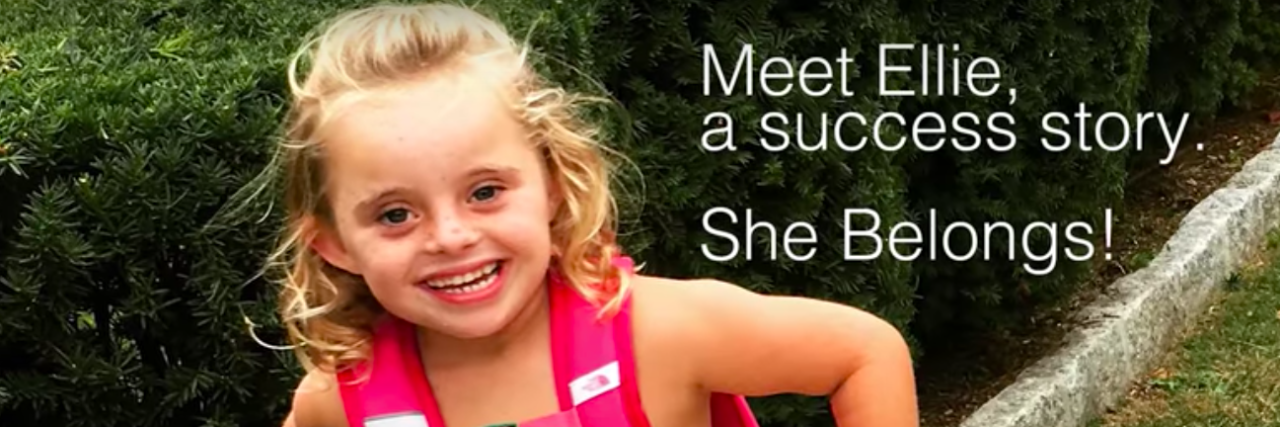Why Inclusion Matters for Kids With Down Syndrome and Other Disabilities
I will never forget squeezing my wife’s hand under the conference table, her eyes teared in elation, when Ellie’s school agreed to educate her in an inclusive Kindergarten classroom. It was an opportunity — actually, a legal right — that far too many students like Ellie are deprived of.
In the coming weeks, hundreds of thousands of parents across the country will meet with their special education administrators to create an individualized education plan (IEP) for the following school year. The IEP establishes educational goals, the setting and the support services necessary to achieve those goals. For my wife and me, the annual IEP meeting marks the beginning of spring and a renewal of our vow to advocate the merits of inclusionary practices on Ellie’s behalf. To us, the term, “inclusion,” means the opportunity our daughter has to learn alongside typically developing students despite the “special” label that accompanies her throughout life. Our wish for special education administrators around the country is to embrace inclusionary practices given the well documented benefits for all students.
Ellie, who is 8 years old, has Trisomy 21, or Down syndrome. Down syndrome is the most common chromosomal condition, and more than 200,000 Americans have it. It is associated with delayed cognitive ability and physical growth.
Decades of research has proven that inclusive education substantially increases academic performance and the rate of employment for individuals with intellectual disabilities. For example, Ellie benefits from modeling speech and behavior patterns after her typically developing peers, and is challenged by the elevated expectations of a general education class. She is reading at a grade appropriate level and meeting many milestones, though not without challenges. And beyond quantitative measures, Ellie is excited to go to school and is engaged in learning. Attending school with her two typically developing brothers validates her place in our community.
Interestingly, research suggests the benefits of inclusion extend to typically developing classmates. The presence of a classmate with an intellectual disability fosters empathy, tolerance and patience. These virtues are fundamental to developing “emotional intelligence,” a concept revered by educators, parenting gurus and business leaders alike. And given no evidence exists that inclusion adversely affects typically developing students, inclusion provides an enriched environment for all students.
Furthermore, the benefits of inclusion extend to adults as well. A recent study by McKinsey & Company, a global consulting firm, found that the presence of employees with Down syndrome in the workplace can improve an employer’s “organizational health,” a measure positively correlated with financial performance. Survey respondents indicated that working with individuals with Down syndrome made them better equipped to handle diversity and manage conflict.
Ellie is enrolled in an inclusive classroom at our public elementary school. While the term “inclusion” is not formally defined by the Department of Education (DoEd), it is generally accepted to mean an education approach by which all students are educated for at least 80 percent of the school day in a general education classroom. Ellie is separated from her classmates only for speech and related therapy sessions and is supported by a teacher’s assistant who tethers her to the pace of the curriculum.
Sadly, Ellie’s positive educational experience contrasts the national norm. According to data from the DoEd, only 17 percent of the 400,000+ students with an “intellectual disability” were educated in an inclusive setting during the 2014-2015 academic year. That statistic varies considerably across state lines, with New York at merely 6 percent whereas neighboring Connecticut is at 36 percent, a rate six times greater. And our Nation’s Capital does not lead by example at a rate of 9 percent with all neighboring states scoring below average. Moreover, these statistics have stagnated for years, reflecting limited improvement, rather than recent anomaly.
To be clear, inclusive education is not appropriate for all students. Some students benefit from specialized resources. However, the relatively low frequency and inconsistent application of inclusionary practices nationwide contradicts the well documented benefits of inclusive education and Federal law.
A key principle of decades old Federal law, called Least Restrictive Environment (LRE), states, “To the maximum extent appropriate, children with disabilities are educated with children who are not disabled, and that their removal from general education occurs only when the nature or severity of the disability is such that education in regular classes with the use of supplementary aids and services cannot be achieved satisfactory.” In short, LRE means that special education is intended to be a “service,” not a “destination.” And it means the school bears the burden to prove that a student cannot be satisfactory educated in a general education setting before denying that placement. Parents, however, often perceive the inverse, that the onus is on them to prove that their child belongs in a general education classroom.
I’ve consulted former senior administrators of the DoEd to understand why the rate of inclusive education is so low. A confluence of factors are cited, but the most significant reason is “attitudinal.” School administrators, while typically well-meaning and subscribers to the LRE principle, sometimes “just don’t see” how inclusion is appropriate for the student at hand. And that student’s parents may not be fluent on the benefits of inclusion or their legal protections. The inherent subjectivity of student assessments and placement recommendations coupled with the information asymmetry tilted toward school administrators enables this subtle discrimination.
My hope for special education administrators is to address the “attitudinal” deficits of our educational system and make “inclusion” a priority, rather than an often ignored obligation. For special education administrators to challenge our teachers to focus on their students’ abilities, rather than disabilities, to think creatively about enabling support services, and to bet on their students rising to the opportunity. To belong. Missed opportunity for inclusion diminishes the education opportunity for students, not merely those branded as “special.” The stakes are high. And yes, this does affect their “permanent record.”
Banner image via YouTube video.

